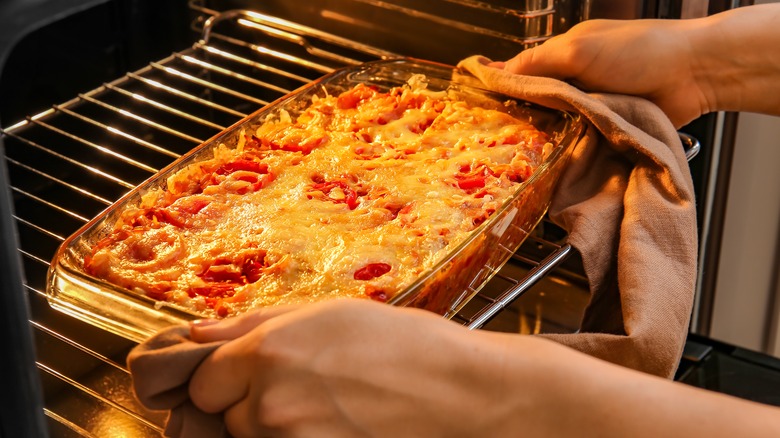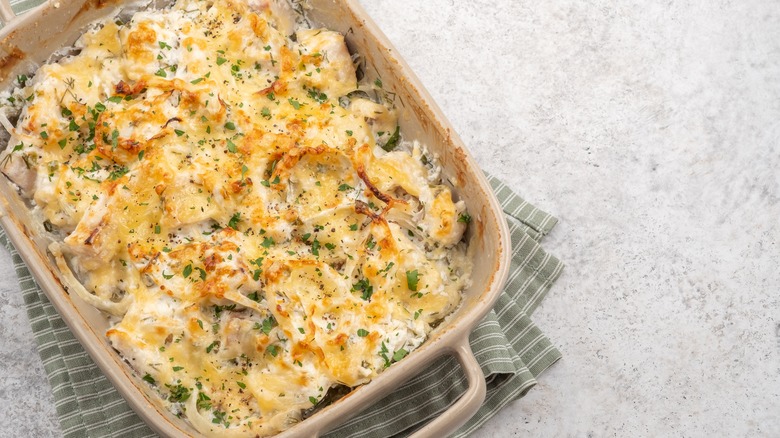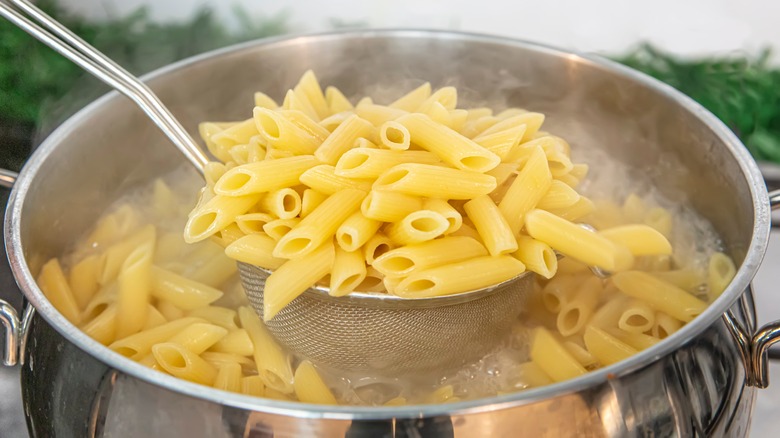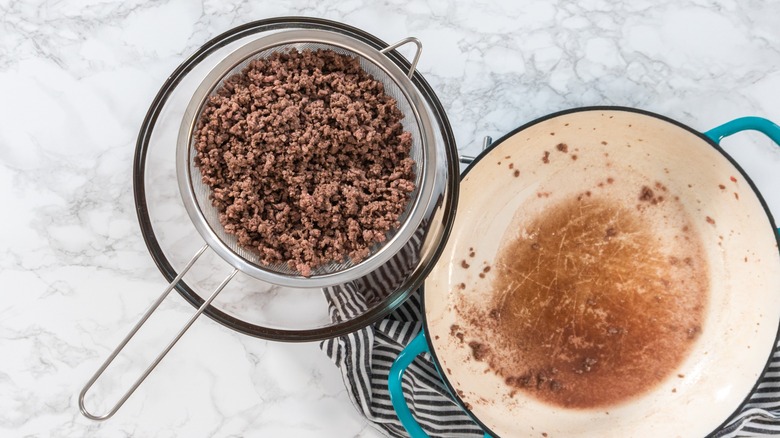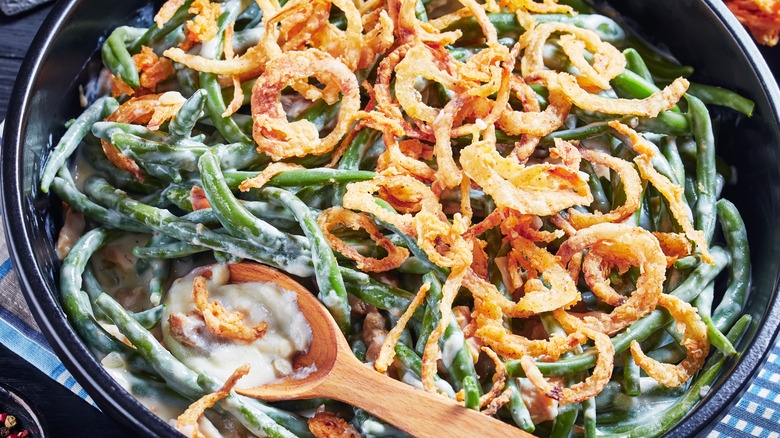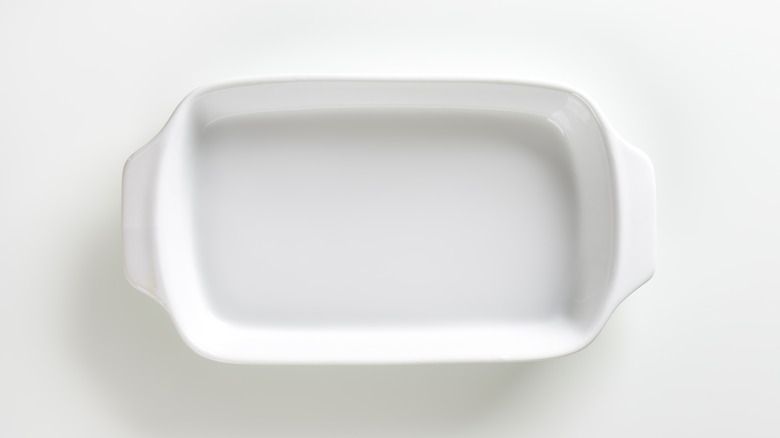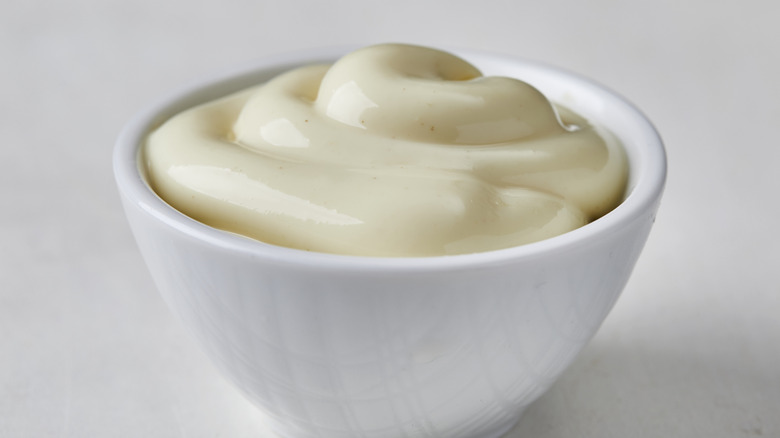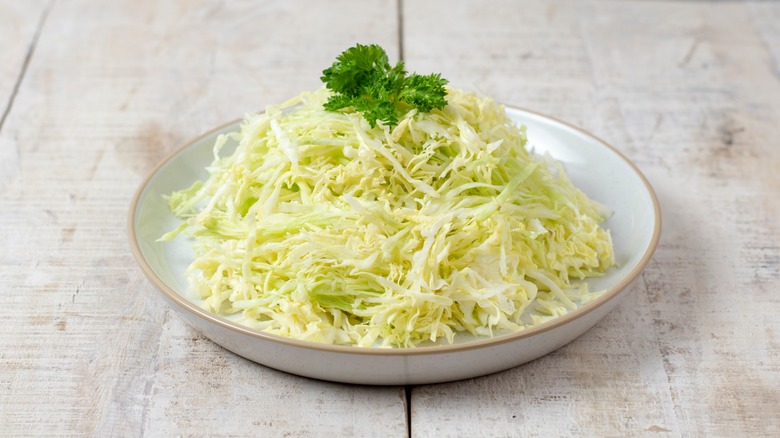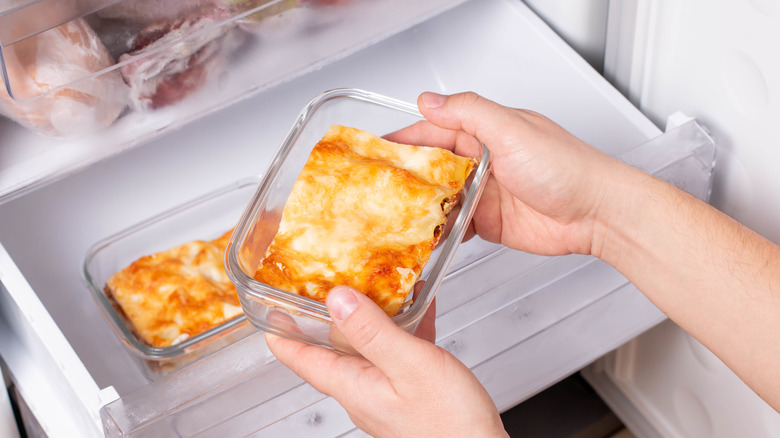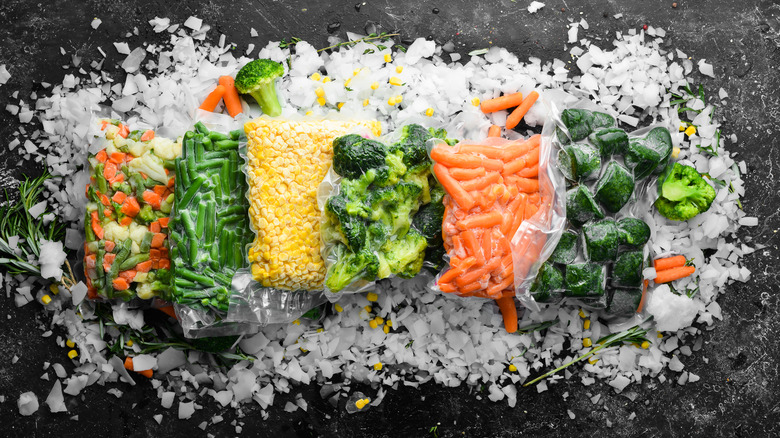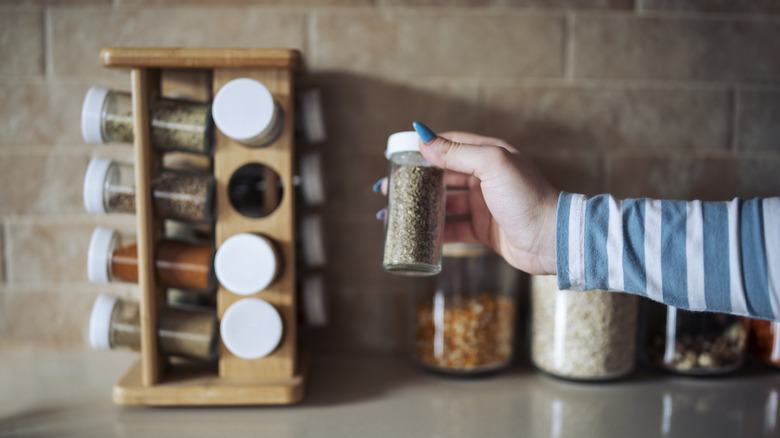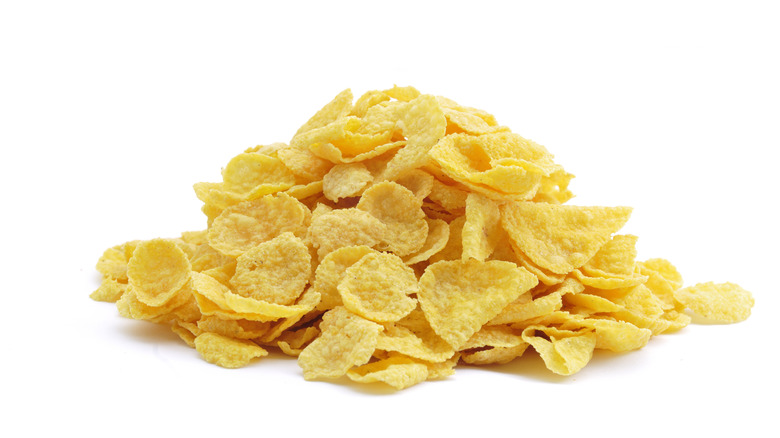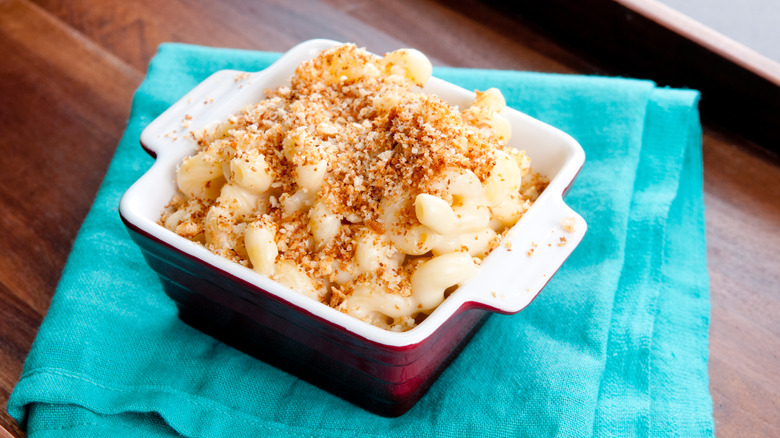12 Tips You Need When Making Casseroles
When you're looking for a quick, easy, and delicious dinner, it's hard to deny the appeal of a good casserole. Casseroles are so convenient because, most of the time, you just have to put the ingredients into a baking dish and then put the dish in the oven. In a matter of a few minutes to a few hours, you'll have a home-cooked meal that you barely even had to touch. Plus, they're generally easy to make in bulk, so you can make dinner for tonight and freeze your leftovers to enjoy later. Perhaps that's why casseroles have enjoyed decades of popularity from families who are trying to save time and money... a task that's easier than it sounds.
Whether you're a casserole veteran or you're getting ready to make one for the very first time, knowing the best tips and tricks is key to casserole success. After all, you don't want to go through all that prep work just to take a pan of slop out of the oven just when you're really getting hungry.
That's why we've compiled some of our favorite casserole-making tips. If you've just jumped on the casserole train, you can learn basic skills to ensure delicious dinners every time. And if you've been making casseroles for years, you may just learn something that'll make your favorite dishes even better. Let's take a closer look at these helpful casserole tips.
Choose the right dish
There are so many different ways to make a casserole — and so many baking dishes to put them in. There's a good chance that you have a dish or two that you always use for your casseroles, but how do you know if you're using the right one? Well, first of all, you're going to want to make sure you're not overstuffing your dish. You should really only be filling your casserole dish up ¾ of the way. Otherwise, your food could become soggy in the middle and take too long to cook all the way through. Make sure that when you measure out all the ingredients you'll need for your casserole that you don't have ingredients spilling out of the pan.
You're also going to want to pay close attention to the kind of dish the recipe calls for. If the recipe calls for a 9 by 13-inch pan and you use one that's a fraction of that size, the recipe isn't going to turn out perfectly. Also, you'll want to think about whether the recipe developer used a casserole dish made of metal, glass, or another type of material. This won't matter in every single recipe you make, but it's something you should keep in mind as you choose a dish in which to cook your casserole.
Use parboiled noodles
Many of the best casserole recipes out there call for pasta, which adds a carby and satisfying element to any dish. But have you ever tried to eat a casserole that had soggy pasta in it? It's a deeply unpleasant experience. So, how do you avoid soggy noodles in your own casseroles?
Many recipes will ask you to add cooked pasta to a casserole recipe before you bake it. However, you should think about how the consistency is going to turn out after you put it in the oven. If you're just baking the casserole for a few minutes to allow the cheese on top to melt, then you may not have to worry about cooking the pasta too much more. However, if you're leaving cooked pasta in a watery casserole for hours, you should expect that the pasta is going to see a lot more heat, which can leave it feeling soggy.
You're better off using parboiled pasta for most of your casserole recipes. By only partially cooking the pasta on the stove, you'll ensure that the extra time in the oven just finishes cooking the pasta instead of turning it into a sad, soft mess. If you don't want to have to worry about parboiling your pasta, try finding a recipe that calls for hard pasta in place of the partially cooked stuff. Casseroles that stay in the oven for longer may not require you to cook your noodles ahead of time.
Drain meat before adding it to casserole
Sometimes, casseroles don't spend enough time in the oven to cook all the way through, which is why you may have to pre-cook some of the ingredients before you turn your oven on. Many recipes will ask you to cook your meat before adding it to the casserole dish. This may raise an important question: Should you drain your meat before adding it to your casserole?
Although it does depend on the kind of meat you're using, generally, you're going to want to drain your meat before you add it to your casserole. If you don't drain your meat, it's not the biggest deal, but you're probably going to end up with a finished product that may be a bit more watery and greasy than you'd really like it to be. And let's be honest: Not everyone wants pools of beef juice floating around their casserole (barf).
However, not all types of meat are created equally. When it comes to high-fat meat (like ground beef and pork), draining is probably your best bet. Other types of meat, though like chicken breast have a very low-fat content to begin with. If you really want to make sure you get enough fat and flavor in chicken-based dishes, you can forget about draining the liquid off the meat and just add it to your casserole dish with the other ingredients.
Don't add onions to green bean casserole in advance
Part of what we love most about casseroles is the fact that they're so easy to make and freeze ahead of time. That way, whenever you have a busy evening and can't be bothered to make dinner, you won't have to get takeout — you'll have a home-cooked meal that's ready and waiting for you in the freezer. However, there are special considerations you have to think about when you're making a casserole in advance. And when it comes to green bean casserole specifically? You'll want to think about your onion strategy.
If you like your green bean casserole with fried onion or shallots on top (which is, if you ask us, the best part of a green bean casserole anyway), you'll want to wait to add them to the finished dish. That's because if you add them to your casserole, freeze it, and then reheat it again, the moisture from all the other ingredients you're using is going to make those fried onions soggy. Since the whole point of adding the onion topping is the crunch that fried onions provide, that sogginess would be a serious bummer. Luckily, you can easily get already prepared fried onions or shallots at many grocery stores, so you can just have a container on hand and shake some of those onions on your casserole when you're ready to serve it.
Avoid a metal baking dish
Of course, the most important part of your casserole to consider is the ingredients themselves — that's what's going to make up the final dish, after all. However, that doesn't mean you shouldn't think about your cooking vessel as well. The kind of baking dish you use can have an effect on how your casserole comes out in the end. If you ask us, you're best off using a ceramic or a glass baking dish for your casseroles. Why? There are a few different reasons to consider.
First of all, metal can impart flavors in your food, changing the way they taste. For example, if you cook tomatoes in a metal baking dish, you may be able to pick up some of those metallic notes once you serve your casserole, which is probably not what you're going for. Perhaps more importantly, though, choosing a metal baking dish means that your casserole is going to cool down way faster than it would otherwise. Since metal is such a good conductor of heat, the pan will heat up fast but cool down just as fast. That means you may be left with a lukewarm casserole just a few minutes after you set it down on the table. If you only have a metal baking dish, it'll certainly get the job done. But for the best (and warmest) results, choose glass or ceramic instead.
Mayo and sour cream can replace canned soup
If you've cooked a lot of casserole recipes in the past, then you may have noticed a common theme: Many of them call for the addition of canned soup, often cream of chicken, cream of mushroom, or cream of celery. Not only do these soups add flavor to a casserole dish, but they also offer a creaminess that can take an average recipe to the next level.
However, not everyone has these soups on hand on a regular basis, and others would prefer not to eat a product that's so processed. Luckily, there's an easy swap you can make in your own casserole dishes, and you may have the ingredients you need already. Instead of using a canned "cream of" soup, try mixing together equal parts mayo and sour cream instead. They'll both give the casserole the creaminess and richness it needs, and the acidity of the sour cream can add flavor and brightness to the final dish. This is a super-easy swap, and since you may already have sour cream and mayo in your fridge, it's one that shouldn't increase the cost of your casserole too dramatically.
Shredded green cabbage works in creamy casseroles
So, you're making a creamy casserole and you want to make sure it's packed with plenty of veggies. You decide on cabbage since it cooks down well, it's mild in flavor, and it adds a lovely texture to a creamy casserole. But what kind of cabbage should you choose? It may seem like a difficult decision to make, especially if you don't work with cabbage a lot, but we think you're better off opting for green cabbage over red. The reason why may surprise you is that it's less about flavor than it is about color.
Red cabbage is gorgeous, but if you've ever added it to a dish with other ingredients, you may have noticed that the dark color bleeds quite a lot. In fact, it can often dye other ingredients in your dish. While that's not a huge problem on the flavor front, it can look unappetizing — especially when you're working with a creamy casserole where that red color can do a lot of damage. If you don't really care how the final product looks, go ahead and use that red cabbage. But if you're trying to avoid those off-colors in your dish, then skip the red stuff and opt for plain old green cabbage instead. It should taste just as good as its red counterpart.
Save and freeze your casserole
We love that casseroles are so easy to make, rendering them ideal for those busy weeknights when you just need to get something on the table without spending much time standing over the stove. But what's even better about casseroles is the fact that you can make them ahead of time and then freeze them to save them for days when you have even less time to cook. You can freeze an entire casserole ahead of time, or you can simply freeze a smaller portion of the meal. And if you're trying to make a meal that you can take on the go, you can even freeze individual portions to take with you and microwave at the office (or wherever else you're going).
There are just a few things you should keep in mind when you're freezing a casserole. Any casserole that contains raw meat should be cooked completely ahead of time, then cooled and frozen, but if you're not working with raw meat, then you can just skip this step. And if you're making a super cheesy dish, you may want to avoid freezing — these generally don't thaw out very well.
Skip the frozen vegetables
Most of the time, we love frozen vegetables. They're useful to have on hand, and they can add a dose of nutritional value to just about any quick meal. Plus, frozen vegetables actually may be healthier than their fresh counterparts — because they're picked at the peak of freshness, they contain more nutrients than fresh veggies. But that doesn't mean that frozen vegetables belong in every dish. When it comes to casseroles, you're going to want to opt for the fresh stuff instead.
Why? It basically all comes down to water content. Frozen veggies contain more water, which can leave your casserole soggy once it comes out of the oven. Sure, it may be more expensive (and take slightly more time) to use fresh vegetables, but the flavor, texture, and overall quality of your casserole will be significantly better if you remember to avoid those frozen vegetables in favor of the fresh veg.
Always add spices
If there's one complaint that casserole haters often cite, it's the fact that casseroles are often lacking on the flavor front. Sure, they may be easy to throw together, but that doesn't necessarily mean that they'll actually taste good. This is why it's so important to use spices in your casseroles. Yes, sometimes salt and pepper may be enough, but oftentimes, you'll need more than that to create a truly flavorful dish. Start experimenting with the different spices you have in your spice rack, and you may just discover that the casserole recipe you've been making for years is actually a lot better when you add a heavy dose of paprika to the mix.
For best seasoning results, don't just add spices to your casserole when you're done combining everything together. Rather, you'll want to season every component separately, then add them all together in one dish. This will ensure that every bite is as flavorful as possible.
Something crunchy rounds it out
When you make a casserole, you're cooking a lot of different components together in one dish, which can sometimes result in a texturally bland final product. If you have a lot of creaminess covering soft, cooked ingredients, the finished casserole may taste kind of lackluster and one-dimensional, even if you season things as you should. Luckily, it's easy to add something to break up all that sameness. We love adding a crunchy element to our casseroles to add an interesting touch of texture to the dish.
If you've ever had a green bean casserole with fried shallots or onions on it before, then you know how well these different textural elements work together. But you don't have to limit your crunchy casseroles to the green bean variety. A wide variety of toppings can add the crunch you're looking for. You may want to try crunchy ingredients like crackers, chips, breadcrumbs, or even cereal for that interesting textural element.
Make single-serve casseroles
Part of the reason casseroles have become as popular as they are is the fact that they're so great for families. All you have to do is prep the ingredients, put them into a dish, bake the casserole, and dinner can feed a crowd. But if you don't have a huge family or you live by yourself, you may assume that casseroles just aren't for you. Well, think again.
Even if you're just cooking for one (or two), you can still enjoy a casserole. As we've mentioned before, you can easily cook a whole casserole, eat what you want for the night in question, and freeze the rest to enjoy at a later date if there are leftovers. Don't even want to make that much? Not a problem. You can invest in a single-serving casserole dish to make easy weeknight casseroles leftover-free. You'll get that homey, comforting casserole flavor without having to contend with stacks of Tupperware.
